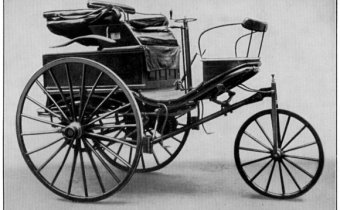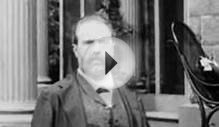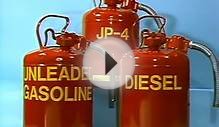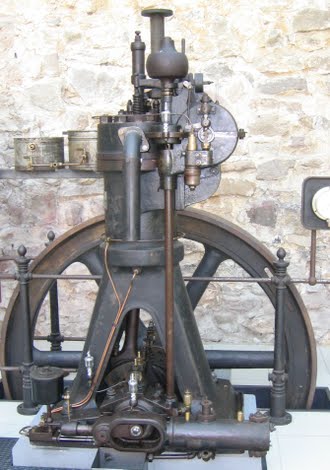
|
by Energy Use and the Internal Combustion Engine The first gasoline-fueled, four-stroke cycle engine was built in Germany in 1876. In 1886, Carl Benz began the first commercial production of motor vehicles with internal combustion engines. By the 1890s, motor cars reached their modern stage of development. In fact, the models of that decade were so successful that there has been no fundamental change in the principles of the ordinary automobile engine since that time. It took several more years for the internal combustion engine to sweep the American market, however. General conditions, such as the expansiveness of the nation, the lack of decent roads, and the relatively well-developed urban transit system, worked against adoption of any and all motor vehicles for a time. Mass production of gasoline-powered cars, however, brought to the market a vehicle that was modestly priced, easy to maintain, relatively fast and powerful, able to travel long distances, and fueled by a cheap, abundant, widely-available source of energy. Before the era of the Model T, gasoline-fueled vehicles had stiff competition from steam-driven and electric cars. In fact, of the 4, 200 cars built in the United States in 1900, only one-fourth employed internal combustion engines. And of the approximately 8, 000 automobiles on the road, most were steam-driven. Steam had been used as early as 1769 to power a road vehicle. French Army engineer Nicholas Joseph Cugnot designed a three-wheel truck for hauling artillery. Experimentation with steam-powered vehicles began in the United States in the 1780s primarily in the Northeast. Into the nineteenth century, however, steam-engine technology tended to focus on locomotives rather than cars. Particularly noteworthy in the United States were steam cars produced by twins Francis E. and Freeland O. Stanley, who had been school teachers in Maine. For several years, the “Stanley Steamer” was the fastest vehicle on the road. In 1906, the Stanley Rocket set five world speed records in Daytona Beach, Florida, hitting over 127 miles per hour. By the 1910s, however, the Stanleys were producing only 600 to 700 vehicles per year. Despite the simplicity of their engines, fast acceleration, low pollution, economy, and great power, the early steamers started up slowly and ran noisily, had unreliable controls and problems with freezing, and required extensive engineering knowledge to operate. Although many of the steamer’s weaknesses were overcome, they suffered from little infusion of capital into their production, some untimely accidents, and vigorous competition from the mass-produced gas-powered cars that had overtaken the market by the 1910s. The electric car, utilizing rechargeable batteries, was another promising alternative to the gas-powered vehicle. In 1900, more than one-quarter of the almost 4, 200 American automobiles produced were electric. However, twenty years later the commercial viability of the electrics had ended. As with the steamers, electric cars had some decided advantages over the motorcar: ease of operation, no emissions of foul odors and gases, and a quiet ride. Yet as a road vehicle, electric cars had a major problem: limited range. At the turn of the twentieth century, they could only go twenty miles before requiring a recharge. Furthermore, storage-battery life was limited and the batteries themselves were bulky. Even the celebrated Thomas Edison could not produce a viable battery in time to compete with gasoline-powered cars. As one writer noted: “Like many products before and after, the electric car was a technological success that found no more than a miniscule market; it was a spectacular flop.” With greater availability of gasoline and oil lubricants after the gigantic Spindletop oil strike in southeast Texas in 1901, and favorable publicity from automobile race results, the gasoline-powered car claimed performance superiority over its competitors. In 1900, Ransom E. Olds switched from producing steam-driven cars to producing gasoline-fueled vehicles, and in 1903, Henry Ford founded a motorcar company specializing in automobiles with internal combustion engines. When Henry Ford put his mass-produced Model T on the market in 1908, the car ceased to be a toy for the rich and firmly entrenched the internal-combustion vehicle as the standard. Demand for gasoline was the major impetus to the growth of the petroleum industry in the twentieth century. Gasoline consumption soared from less than three billion gallons in 1919 to approximately fifteen billion in 1929, 46.5 billion in 1955, and more than 135 billion in 2002. By 1973... |
RELATED VIDEO




 A diesel engine (also known as a compression-ignition engine) is an internal combustion engine that uses the heat of compression to initiate ignition to burn the fuel, which is injected into the combustion chamber. This is in contrast to spark-ignition engines such...
A diesel engine (also known as a compression-ignition engine) is an internal combustion engine that uses the heat of compression to initiate ignition to burn the fuel, which is injected into the combustion chamber. This is in contrast to spark-ignition engines such...
 A four-stroke engine, also known as four-cycle, is an internal combustion engine in which the piston completes four separate strokes—intake, compression, power, and exhaust—during two separate revolutions of the engine's crankshaft, and one single thermodynamic...
A four-stroke engine, also known as four-cycle, is an internal combustion engine in which the piston completes four separate strokes—intake, compression, power, and exhaust—during two separate revolutions of the engine's crankshaft, and one single thermodynamic...








